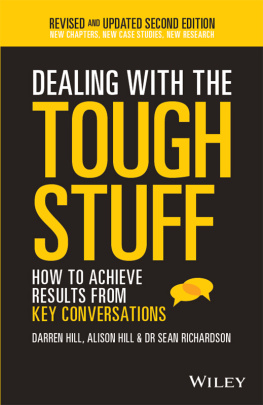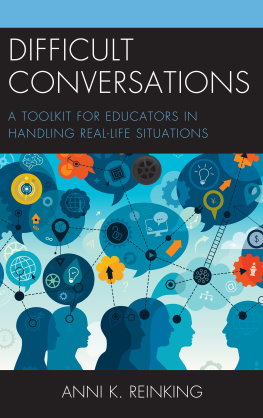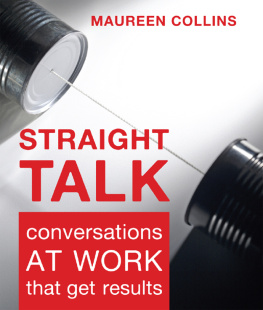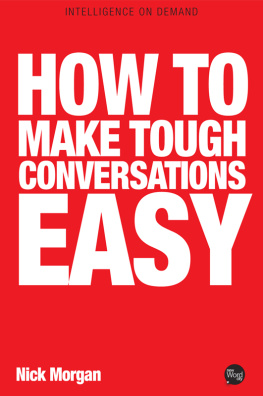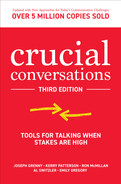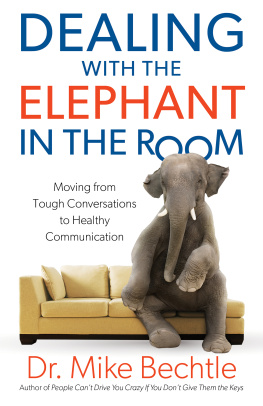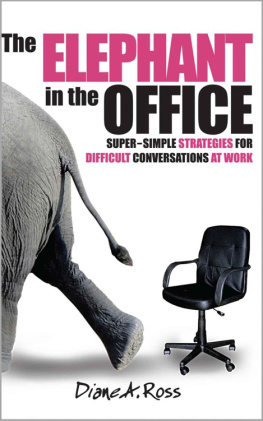
This edition first published in 2016 by John Wiley & Sons Australia, Ltd
42 McDougall St, Milton Qld 4064
Office also in Melbourne
Pragmatic Thinking Pty Ltd 2016
The moral rights of the authors have been asserted
National Library of Australia Cataloguing-in-Publication data:
| Creator: | Darren Hill, author. |
| Title: | Dealing with the Tough Stuff: How to achieve results
from key conversations / Darren Hill, Alison Hill and
Dr Sean Richardson. |
| Edition: | 2nd edition |
| ISBN: | 9780730327004 (pbk.)
9780730327011 (ebook) |
| Notes: | Includes index. |
| Subjects: | Communication in management Handbooks, manuals, etc.
Conversation Handbooks, manuals, etc.
Personnel management Handbooks, manuals, etc.
EmployeesRating of Handbooks, manuals, etc.
Self-actualization (Psychology) Handbooks, manuals, etc. |
Other Creators/
Contributors: | Hill, Alison C., author, Richardson, Sean, author. |
| Dewey Number: | 658.3145 |
All rights reserved. Except as permitted under the Australian Copyright Act 1968 (for example, a fair dealing for the purposes of study, research, criticism or review), no part of this book may be reproduced, stored in a retrieval system, communicated or transmitted in any form or by any means without prior written permission. All inquiries should be made to the publisher at the address above.
Cover design by Wiley
Internal and cover illustrations Pragmatic Thinking Pty Ltd
Disclaimer
The material in this publication is of the nature of general comment only, and does not represent professional advice. It is not intended to provide specific guidance for particular circumstances and it should not be relied on as the basis for any decision to take action or not take action on any matter which it covers. Readers should obtain professional advice where appropriate, before making any such decision. To the maximum extent permitted by law, the authors and publisher disclaim all responsibility and liability to any person, arising directly or indirectly from any person taking or not taking action based on the information in this publication.
Preface
It all started with a printer.
Sue used to send her printing to the printer but, rather than immediately picking it up, would leave it for a few minutes sometimes hours. Not with any intent. She just got distracted. But before casting a stone for this heinous crime, admit it: we have all done it.
John didn't like having to sort out someone else's printing when fetching his own. Who does? So one day he decided enough was enough and put up a sign above the printer. The sign read:
PLEASE PICK UP YOUR PRINTING.
IT IS DISRESPECTFUL TO LEAVE IT
FOR OTHERS TO SORT OUT.
Of course, you know what happened next. Sue who left her stuff in the printer saw the sign as a direct attack on her and felt offended and humiliated. And she responded in kind. Sue's retaliation wasn't overt or loud, but in her mind she placed a black mark against everything and anything John said or did in the office. It started with small things: expressing opinions contrary to John's at the team meeting and refusing to participate in projects or working groups that John was involved in.
John also changed his behaviour towards Sue. Responding to Sue's contrary behaviour, John made every attempt to point out flaws, mistakes or shortcomings in Sue's work to anyone in the office who would listen.
The relationship had quickly become adversarial the battlelines had been drawn.
Fast forward four years.
The team that Sue and John belong to is in total disarray. There are now not one, but two longstanding grievance procedures in place. Turnover of the best staff has been high, and morale and productivity are at an all-time low. Chaos reigns supreme.
The dysfunction within the work team has resulted in several workers' compensation claims for psychosocial injury (that's a fancy term for stress leave), and the cost to the organisation of this dysfunctional team is now estimated to be more than one million dollars.
How did things go so wrong?
The better question is this: Who is responsible?
It's easy to start with the person who left their printing behind, or perhaps the blame could be directed at the person who put up the rather direct sign. But the cold, hard truth is that the responsibility for this whole mess lies with the manager of the section, who did not control the key conversations that needed to happen at the start.
Blowups occur. Interpersonal tensions happen. It's a fact of life when you put two or more people in the same vicinity. Whether it's a difference in values, beliefs, actions, expectations or what we like or dislike for lunch, we're all unique and have our own opinions, and at some point that difference is bound to manifest in a potential disagreement or conflict.
While Sue and John's example may seem dramatic at face value (one million dollars in lost productivity, let alone the personal costs involved), the reality is that this situation is all too common. You may have a similar story to tell.
Our workplaces and society have forgone the necessary direct conversations in favour of cotton wool and avoidance. We have created systems, procedures and policies that enable longstanding conflict to survive through layers of bureaucracy and hinder quick resolution through robust conversation. The cost of this approach is considerable on so many levels, and yet these costs can be minimised, mitigated and even eliminated by a manager who leads well in a time of crisis.
If leadership is measured on a continuum, at one end might be maligned leadership, where the people who work for you speak badly of you, and maliciously obstruct or even sabotage their own or your work efforts. It's not a great place to be.
The other, more desirable, end of the management continuum is aligned leadership, where the thoughts, attitudes and behaviours of the entire workgroup come into line with each other.
In essence, the gap between aligned leadership and maligned leadership boils down to two things:
- the decisions we make
- the actions we take.
In picking up this book, you have made a very good decision.
As for the actions you take well, that's where you come in, and we are in your corner all the way.
Darren, Alison and Sean
March 2016
About the authors

Darren Hill is one of Australia's most in-demand strategists with a client book of Fortune 50 and ASX Top-20 companies. The culture-change programs Darren works on have been used in PepsiCo, McDonald's, Siemens, Suncorp Bank and the Australian Federal Government to name a few.
Darren is a best-selling author whose work has appeared regularly across the Fairfax Group (including the Sydney Morning Herald and TheAge), News Limited (The Daily Telegraph and TheCourier-Mail), Business Insider and Smart Company. He now writes exclusively for BRW, and has appeared on the Today' show and Sky's Business News'.
A behavioural scientist and Executive Director at Pragmatic Thinking (www.pragmaticthinking.com), Darren understands people like few others do. It is his intricate knowledge of people and culture that sees him not only delivering international keynote presentations at conferences but also designing, delivering and implementing complex, cross-layered multiyear culture-change programs inside organisations.
Next page
